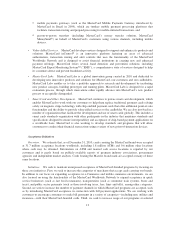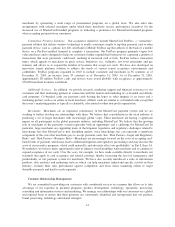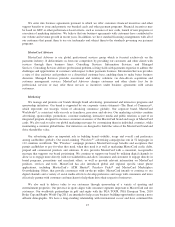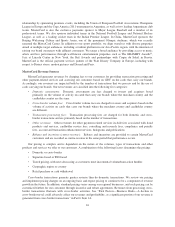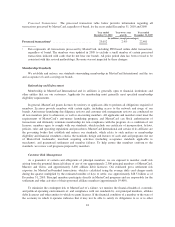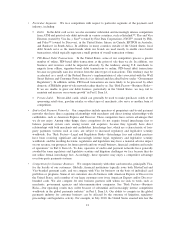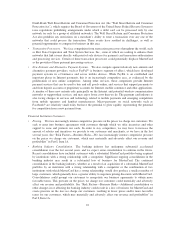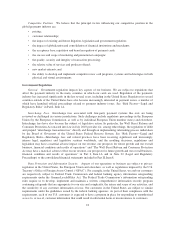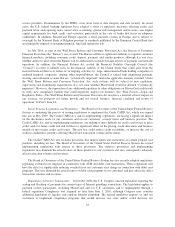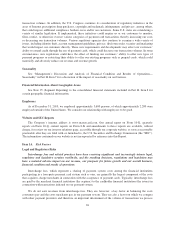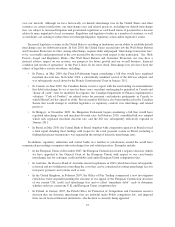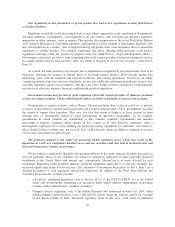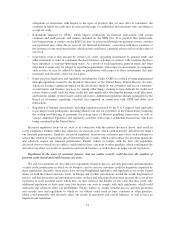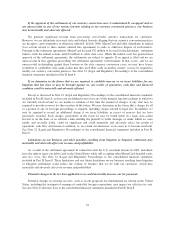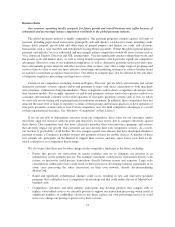MasterCard 2010 Annual Report Download - page 33
Download and view the complete annual report
Please find page 33 of the 2010 MasterCard annual report below. You can navigate through the pages in the report by either clicking on the pages listed below, or by using the keyword search tool below to find specific information within the annual report.Competitive Position. We believe that the principal factors influencing our competitive position in the
global payments industry are:
• pricing;
• customer relationships;
• the impact of existing and future litigation, legislation and government regulation;
• the impact of globalization and consolidation of financial institutions and merchants;
• the acceptance base, reputation and brand recognition of payment cards;
• the success and scope of marketing and promotional campaigns;
• the quality, security and integrity of transaction processing;
• the relative value of services and products offered;
• new market entrants; and
• the ability to develop and implement competitive new card programs, systems and technologies in both
physical and virtual environments.
Government Regulation
General. Government regulation impacts key aspects of our business. We are subject to regulations that
affect the payment industry in the many countries in which our cards are used. Regulation of the payments
industry has increased significantly in the last several years, including in the United States. Regulators in several
countries outside of the United States have also become increasingly interested in payment issues, a number of
which have launched official proceedings related to payment industry issues. See “Risk Factors—Legal and
Regulatory Risks” in Part I, Item 1A.
Interchange Fees. Interchange fees associated with four-party payment systems like ours are being
reviewed or challenged in various jurisdictions. Such challenges include regulatory proceedings in the European
Union (by the European Commission, as well as by individual European Union member states) and elsewhere.
Interchange fees have also become the subject of legislative action. In particular, the Wall Street Reform and
Consumer Protection Act enacted into law in July 2010 provides for, among other things, the regulation of debit
and prepaid “interchange transaction fees” directly and through an implementing rulemaking process undertaken
by the Board of Governors of the United States Federal Reserve System. See “Risk Factors—Legal and
Regulatory Risks—Interchange fees and related practices have been receiving significant and increasingly
intense legal, regulatory and legislative scrutiny worldwide, and the resulting decisions, regulations and
legislation may have a material adverse impact on our revenue, our prospects for future growth and our overall
business, financial condition and results of operations” and “The Wall Street Reform and Consumer Protection
Act may have a material, adverse effect on our revenue, our prospects for future growth and our overall business,
financial condition and results of operations” in Part I, Item 1A and in Note 22 (Legal and Regulatory
Proceedings) to the consolidated financial statements included in Part II, Item 8.
Data Protection and Information Security. Aspects of our operations or business are subject to privacy
regulation in the United States, the European Union and elsewhere, as well as regulations imposed by the U.S.
Treasury’s Office of Foreign Assets Control (“OFAC”). For example, in the United States, we and our customers
are respectively subject to Federal Trade Commission and federal banking agency information safeguarding
requirements under the Gramm-Leach-Bliley Act. The Federal Trade Commission’s information safeguarding
rules require us to develop, implement and maintain a written, comprehensive information security program
containing safeguards that are appropriate for our size and complexity, the nature and scope of our activities, and
the sensitivity of any customer information at issue. Our customers in the United States are subject to similar
requirements under the guidelines issued by the federal banking agencies. As part of their compliance with the
requirements, each of our U.S. customers is expected to have a program in place for responding to unauthorized
access to, or use of, customer information that could result in substantial harm or inconvenience to customers.
23


